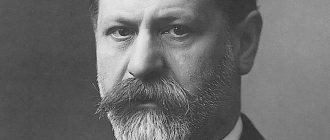Today, the most common form of psychotherapy is cognitive psychotherapy. It is based on the assumption that the causes of human mental problems are erroneous thoughts. If they are detected and eliminated, then you can not only get rid of various mental disorders, but also prevent their occurrence in the future.
Cognitive psychotherapy pays little attention to a person’s childhood memories, focusing on current problems, his inner world, thoughts, desires and fantasies. This is the main difference between this method of treating mental disorders and other popular types of psychotherapy: psychoanalysis and behavioral therapy.
The founder of cognitive therapy is Aaron Beck. Initially, he was engaged in psychoanalysis, but gradually became disillusioned with it and began to look for new methods of treating depression and affective disorders. Beck argued that the world around us is not bad, it is negative views of it that shape negative emotions and actions. Distortion of external circumstances in consciousness leads to the development of mental pathology, for example, depression.
Albert Ellis, the developer of the method of rational-emotive psychiatry, which has much in common with cognitive psychotherapy, worked independently of Beck. Today, cognitive therapy is a component of the cognitive-behavioral (behavioral) theory used by psychotherapists in their practice.
Goals and methods of cognitive psychotherapy
The main goal of cognitive psychotherapy is to identify dysfunctional thoughts in the patient and their subsequent transformation. But, besides this, experts identify five goals of cognitive therapy:
- complete elimination of the symptoms of the disorder or reduction in the manifestations of the pathology;
- prevention of relapse after correction of mental state;
- improving patients’ perception of other types of therapy, including medications;
- resolution of a person’s psychological and social problems that may arise against the background of the disorder or immediately before its manifestation;
- elimination of the prerequisites that gave impetus to the development of the disorder.
During treatment, the therapist helps the patient understand the extent to which his thoughts influence his behavior, emotions, and physical condition. After a full course of cognitive therapy, a person can independently identify thoughts that negatively affect his psychological state. And most importantly, change dysfunctional beliefs into more rational thoughts.
The main methods of cognitive therapy include combating negative thinking, using alternative strategies for perceiving problem situations, re-experiencing events from the past, and imagination. Each of these methods is aimed at giving the patient the opportunity to relive and forget negative experiences, as well as acquire new learnings.
Cognitive psychotherapy is often complex. In addition to cognitive methods, psychotherapists in their work use various behavioral techniques that successfully complement each other.
The most popular cognitive psychotherapy techniques
Treatment of mental disorders using cognitive psychotherapy is not just a way to combat a specific disease. This approach to therapy gives the patient a special perspective on everything that happens in his life. Thus, it is possible to prevent the development of relapses and other mental disorders. A person trained in the basics of cognitive psychotherapy is able to systematically monitor his own negative emotions and transform them into rational thoughts. This method is especially effective in combating panic attacks.
All techniques used in cognitive psychotherapy can be divided into two large groups:
- techniques aimed at identifying automatic thoughts of a negative nature. The main way to achieve this goal is to interview the patient, but the therapist can also use role-playing techniques. After the automatic thought is found by the patient, the therapist must check it with behavioral factors, as well as logical analysis. In some cases, the identified beliefs turn out to be a mythologem, but most often such thoughts nevertheless take place in reality, although they are not realized by the patient. The therapist must identify the relationship between the automatic thought and the traumatic situation and pathological emotional reactions;
- techniques that allow you to identify the unreasonableness of an automatic thought and cognitively reconstruct it. A person will be able to abandon a maladaptive thought only if he is completely sure of its “wrongness.” First of all, the validity of such thinking can be verified by its consequences. This technique is called decatastrophizing or “what if.” The patient imagines the consequences of the situation that frightens him, and understands that in fact nothing terrible will happen. You can push a person to check irrational thoughts with real actions. If the patient suffers from depression, believing that he is not capable of anything, then he can be given small tasks. Their successful implementation will restore a person’s faith in his own strength. The psychotherapist can also invite the patient to compare his situation with another case from his practice. By feeling sorry for a patient with similar problems, the patient automatically feels sorry for himself. As a result, the negative attitude towards oneself changes into pity and sympathy. A similar result can be achieved using the catharsis method, when the therapist encourages the patient to speak out and cry. In addition, there are a large number of other methods that allow you to change cognitive attitudes.
Throughout the course of therapy, the patient receives homework. He must track automatic thoughts and record his feelings in a special notebook. A psychotherapist may recommend reading certain literature and listening to recordings of psychotherapy sessions.
Most often, psychotherapy is individual, but group work can also be used. In the latter case, not the relationships between its individual members are examined, but the rationality of their thinking and behavior is assessed.
When can cognitive psychotherapy help?
Cognitive psychotherapy is used in the correction of most mental and psychoemotional disorders. But most often this type of therapy is used to treat depression. A depressed person experiences an exaggerated sense of loss, which may be real or imaginary.
Depression is characterized by the presence of negative thoughts of several directions. First of all, the patient develops a negative image of himself; he considers himself a loser, an inferior person. At the same time, they are given a negative assessment of the world around them and passing events, as well as their own future. Experts call this the cognitive triad of depression. To overcome this psycho-emotional disorder, it is necessary to work in each of these directions, replacing dysfunctional thoughts with rational thinking.
In addition to treating unipolar depression and increased anxiety, this type of therapy is also used to eliminate obsessive-compulsive disorder, various phobias, eating disorders, migraines, anxiety and anger attacks, and other personality and behavioral disorders.
Cognitive methods can be part of complex therapy in the treatment of schizophrenia and bipolar affective disorder. The combination of psychotherapy with medication can eliminate hallucinations in patients with schizophrenia and mitigate other symptoms of this pathology. Researchers have proven its effectiveness in the correction of many somatic diseases.
During therapy, the therapist works to solve the problem; he does not change the patient's personality characteristics or shortcomings. From the very beginning, the patient and therapist must come to some kind of agreement, outline the range of problems on which they have to work. It is possible to eliminate the manifestations of the above-mentioned disorders with the help of experimental testing of disaptive thoughts.
Benefits of Cognitive Behavioral Psychotherapy
Behavioral cognitive psychotherapy, the exercises of which have been proven to change the neurotransmitter background of the central nervous system, is not least because of this, one of the most widespread in the modern world.
Cognitive psychotherapy for personality disorders, obsessive-compulsive disorders, depression, hypomania, other affective and neurotic disorders, and even the psychotic level without exacerbations - the list is constantly expanding as more and more verified data on the clinical effectiveness of the method are obtained.
But cognitive psychotherapy is used not only as a treatment tool: confidence exercises are used for individual and group work on personal growth, and in cohesion training.
In essence, cognitive psychotherapy is a “hygiene” of thinking, which, through painstaking work, delicately and without violence, clears maladaptive patterns of behavior from the mind, replacing them with adaptive, harmonious models of intra- and interpersonal development, and also teaches to prevent the consolidation of pathological cognitions in later life.
Specialists
Ashmeiba Nino Anatolyevna
Psychotherapist, psychiatrist
doctor of the highest category
more than 15 years of experience
37 positive reviews
- Suggestive therapy
- Reconstructive-personal psychotherapy
- Rational psychotherapy
- Individual psychotherapy
Make an appointment
Fastovets Elena Vladimirovna
Psychotherapist, psychiatrist
more than 15 years of experience
59 positive reviews
- Individual psychotherapy
- Family psychotherapy
- Cognitive behavioral psychotherapy
- Reconstructive-personal psychotherapy
Make an appointment
Abakumova Elena Viktorovna
Psychiatrist, psychotherapist
more than 20 years of experience
90 positive reviews
- Ericksonian hypnosis
- Neurolinguistic programming
- Cognitive behavioral psychotherapy
- Holotropic Breathwork
Make an appointment
Krylatykh Victoria Yurievna
Psychotherapist, psychiatrist
more than 15 years of experience
115 positive reviews
- Individual psychotherapy
- Family psychotherapy
- Neurolinguistic programming
- Cognitive behavioral psychotherapy
Make an appointment
Zherekhov Alexey Borisovich
Psychotherapist, psychiatrist
more than 15 years of experience
29 positive reviews
- Body psychotherapy
- Cognitive behavioral psychotherapy
- Child-parent relationships
- Art therapy
Make an appointment
Mamaeva Yulia Vladimirovna
Psychotherapist, psychiatrist
first category doctor
more than 10 years of experience
1 positive review
- Individual psychotherapy
- Group psychotherapy
- Child-parent relationships
- Art therapy
Make an appointment
If you find it difficult to choose a psychotherapist, call us or fill out an application. We will help you find a specialist with whom you will feel comfortable.
Fill out an application
Special techniques
To treat some severe mental disorders, special cognitive therapy techniques are used. They are combined with medications and other types of mental health care. In this way, it is possible to reduce the severity of the symptoms of the disorder and increase the effectiveness of the main treatment.
Among the special methods of cognitive psychotherapy, the most popular are the methods used to treat such pathologies:
- Obsessive-compulsive disorder. When correcting this disease, the “four steps” method, developed by American psychiatrist Jeffrey Schwartz, is used. The goal of this treatment method is to change or simplify obsessive thoughts and “rituals” procedures, as a result they are reduced to a minimum. The patient must become aware of his illness and learn to resist its manifestations. The therapist explains to the patient which of his fears are real and which are caused by the disease. They are clearly differentiated, and the patient is shown a model of behavior of a healthy person. Typically, people who represent authority for the patient are chosen as examples. Work in this direction is being carried out in stages, in four steps. This is why the cognitive treatment method for OBD received its name.
- Schizophrenia. This type of disorder is incurable, as it is associated with changes in the cerebral cortex. But the use of cognitive and behavioral therapy methods allows people suffering from schizophrenia to accept their illness and learn to smooth out its manifestations. If the patient constantly conducts conversations with otherworldly entities or imaginary images, then the psychotherapist helps him understand that the conversations are not with living people. Gradually, the person with schizophrenia realizes that his interlocutor is a figment of his imagination, as a result of which such conversations are given less importance. Over time, the patient recalls the imagined image from memory less and less often.
- Addictions. Alcoholism and drug addiction are also caused by a person's incorrect automatic thoughts. A feature of the cognitive approach to treating these disorders is that the therapist must first talk with the patient about his long-term plans and life priorities. After all, a person’s short-term goals should depend on this. First of all, he needs to explain that the main goal of any living being is survival. All animals and people enjoy things that promote procreation and survival, such as food, sex, etc. Processes that harm life cause negative sensations (hunger, cold or heat). All these sensations are transferred to actions or situations associated with them. But a person suffering from some type of pathological addiction has a new source of pleasure that was not provided for by nature. As a result, the patient becomes unnecessary natural joys, he sets himself the goal of obtaining pleasure through artificial means, which is harmful to his health and survival. The therapist must convince the drug addict or alcoholic that with a certain desire he can achieve the right goals, which will allow him to get rid of depression and a painful return to reality. It is possible to lift your mood in a natural way if you improve the quality of your own life, increase your self-esteem and “rise” in the eyes of others. Psychotherapists draw up a “wish map” for patients with addictions. This is a diagram that indicates the relationship of basic values necessary for survival with instincts and complex summary associations. This card, among other things, indicates exactly how addiction harms long-term plans and prevents you from fully enjoying life. Using this technique, you can save the patient from most harmful habits, for example, gluttony, gambling or Internet addiction.
The effectiveness of cognitive psychotherapy in the treatment of these severe mental disorders is quite high, as confirmed by numerous studies in this area. Cognitive and behavioral therapy can reduce the likelihood of relapse of the disease several times.
Cognitive impairment
Hello. My name is Dmitry Aleksandrovich Ovchinnikov, I am a neurologist and functional diagnostics doctor at the Scandinavia Clinic. Today we will talk about cognitive functions and their disorders.
Higher brain function or cognitive function is the most complex function of the nervous system, which is responsible for rational perception, cognition and interaction with the outside world. There are several of them, depending on different authors, but in general, these are memory, praxis, gnosis, speech and executive functions. They are important for us not only when implementing some complex, highly intellectual tasks, but also during the most routine everyday activities. We can consider how we use these functions in everyday life. Well, for example, as soon as we find ourselves in the kitchen and see, say, an egg, our brain turns on all its functions in order to analyze this situation and draw some conclusions. When we take this object, an egg, into our attention, we draw a number of conclusions about its characteristics. That it is a hard, round and white object. Our memory tells us that this is an edible product. Our abilities, praxis, allow us to perform a series of actions in order to prepare it. With the help of speech, we can call someone to take food and, moreover, we can draw more complex conclusions by remembering that, say, someone is allergic to it and should not consume this product. You can see how many functions our brain has used to perform such a simple task. Therefore, a violation of even one cognitive function leads to significant maladaptation of a person and disruption of his interaction with the outside world.
The complete or partial loss of any cognitive function is called cognitive deficit. It can range from mild impairment to profound cognitive impairment or dementia. The first is mild cognitive impairment. This type of cognitive impairment is characterized by very mild, minor changes in concentration, short-term working memory, and the ability to concentrate on one type of work. As a rule, these disorders are transient and have a neurodynamic nature. Of greatest interest to doctors and patients is also mild cognitive deficit. This is a phenomenon that is highlighted by both Russian and Western neurologists and psychiatrists. This is a moderate cognitive deficit or mild cognitive impairment - cognitive impairment that leads to maladjustment in life, but does not reach the level of dementia.
Moderate cognitive deficit is of significant interest both as an independent condition and as a prognostic factor. Because it is known that in 80% of patients who are diagnosed with moderate cognitive impairment, over the next 5 years, these mild cognitive impairments progress to the level of dementia. Therefore, it is extremely important to detect these mild cognitive disorders in a timely manner, perform diagnostic manipulations and take measures to make a diagnosis, identify the causes of these disorders and then determine treatment.
Dementia is a severe cognitive disorder that leads to significant maladaptation of the patient in everyday and professional activities. In other words, dementia is a condition in which a person loses vital everyday and professional skills. There are several types of dementia. These are dementia with Lewy bodies, Alzheimer's disease, vascular dementia, frontotemporal dementia and other types. They differ in the characteristics of the clinical course, in the time of development of this condition, in the rate of progression of the disease and in the accompanying symptoms.
So, for example, Alzheimer's disease can be senile, that is, senile dementia, and there can be early-onset Alzheimer's disease, which can debut even around 50 years of age. Accordingly, depending on the type of dementia, the patient will have a different clinical picture, and the approaches to diagnosis and treatment will differ somewhat. It is important to note that after the clinical onset of dementia, the rate of progression of this condition can be very significant. In this connection, its timely diagnosis is extremely important.
It should be noted that cognitive impairment at a young age may differ from cognitive impairment at an older age in both causes and manifestations. In young people, as a rule, the causes of cognitive impairment are pathologies of the perinatal period and the period of birth. In older people, cognitive impairment may be caused by the natural course of aging. However, in this case, the degree of cognitive impairment will be very minor and will not lead to significant impairment of daily activities. Cognitive impairments can be of a secondary nature and result from diseases and conditions such as traumatic brain injuries, tumors, vascular diseases, infectious diseases, hormonal disorders, metabolic disorders, neurodegenerative diseases and other systemic diseases.
It must be remembered that the use of a number of psychoactive substances can also affect cognitive functions. If we are talking about elderly patients, then it is very important to evaluate what other drugs the person is taking, because a large range of drugs, even non-psychiatric, cardiological, endocrinological, have side effects such as decreased concentration, decreased memory and a number of other cognitive functions .
Finally, an important factor that can influence concentration and memory is our emotional background. Patients with anxiety and depressive disorders, even those that do not reach the psychiatric level, may have some changes in cognitive function. These influences on cognition and emotional state can only be identified through clinical interviewing and the use of special tests. To determine the presence of cognitive disorders, the main methods are clinical interviewing and the use of special scales. Electrophysiological methods, for example, the method of evoked cognitive potentials, can be auxiliary techniques. Methods for identifying the causes of existing disorders are extremely diverse. These include laboratory techniques that determine changes in the composition of blood and other biological media. Radiation diagnostic methods such as MRI, which can detect structural changes in the brain. Methods of functional diagnostics, allowing to determine dysfunctions of a particular organ. However, with such a variety of instruments, the axis around which complaints, examination results, results of objective and instrumental examination, and patient history are collected is the contact between the doctor and the patient. Because only a doctor can determine the indications for the necessary types of research and then prescribe the necessary treatment.
Publication date: 12/08/16










